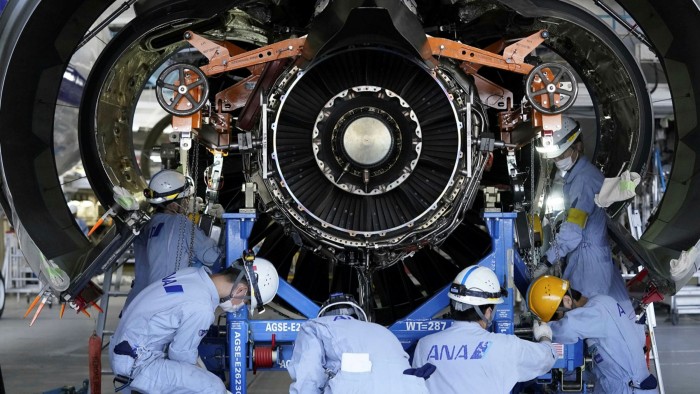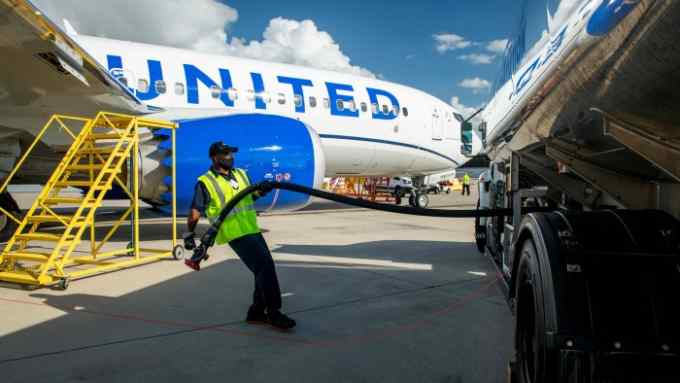Aircraft groups seek increased supply of skilled people and parts

Simply sign up to the Aerospace & Defence myFT Digest -- delivered directly to your inbox.
Covid, the Ukraine war and the aftermath of Brexit are continuing to disrupt the aerospace industry’s supply of people, as well as parts.
Staffing shortages have caused airports such as London’s Heathrow to cancel thousands of flights, while aircraft manufacturers are experiencing longer lead times on their production lines. Last month, reports from the US suggested Boeing would be struggling to meet its target of manufacturing 31 737 Max single-aisle jets a month because suppliers are not delivering key parts on schedule.
Aerospace supply chains have become more fragile due to greater globalisation, increased complexity, as well as price inflation amid the Russia-Ukraine war, says Dave Food, head of supply chain at planning software specialist Board International.
“Macroeconomic events have put the defence and aerospace sectors under increased pressure following a post-pandemic awakening,” he adds. “The economic unrest has instigated a wave of new challenges, with sanctions and conflict restricting the flow of critical resources. Concerns about the titanium supply chain are also being raised by the conflict between Russia and Ukraine, with major raw materials, metal, and alloy producers serving customers across the globe situated on both sides of the border.”
Defence companies will probably experience a more changed market than commercial aircraft manufacturers as a result of Russia’s invasion of Ukraine and more military spending, globally, Food says. “The conflict has prompted many Nato members to increase their defence budgets, which is likely to increase expenditures on spare parts and maintenance services for a short while, and on larger defence equipment in the future.”
Food believes the key to “keeping the supply chain afloat” for aerospace groups is having greater visibility of supply chain constraints, investing more in research and development, allocating workforce and technology resources adequately, and fostering industry collaboration.
However, as demand for commercial, civil and defence aviation recovers, the difficulty for companies is returning employee headcount to pre-pandemic levels and possessing all the fundamental skills, says Warrick Matthews, chief procurement officer at Rolls-Royce Civil Aerospace.
“In some markets, we have suppliers who, when they held careers days 3-4 years ago, would have had a queue going around the block, but now they are really struggling to find people,” he says.
“They cut pretty hard to get through the pandemic and anticipated that, when the growth came back, they would just rehire. They now face some real challenges where there has been a change of attitude in the workforce, such as not wanting to work in the industry or not wanting to work on shifts, for example.”
Rolls-Royce Civil Aerospace has responded to these challenges by bolstering partnerships with high-performing suppliers. “It’s not a coincidence that we have awarded £3.2bn of long-term agreements to that group in the last two years,” says Matthews. “This is a strategic decision that helps us minimise our exposure to key technologies and build a more resilient, sustainable supply chain.”
Consolidation can be “a double-edged sword”, though, suggests Steven Wood, senior commercial manager at UK innovation centre Digital Catapult — as it can simplify the aerospace supply chain but decrease its diversification.
“Having only two or three major suppliers can make them complacent and slow and it stifles innovation,” he says. “Increasing the number of companies to include non-traditional defence suppliers — which are often smaller, disruptive and more agile — introduces much needed new ideas, responsiveness and adaptability, and this can act as an example for incumbents to adopt.”
A diverse supply chain can also help aerospace companies close skill gaps. Wood says: “Large defence suppliers find it hard to attract and retain people with advanced digital skills — small innovators simply do not. The same effect occurs with technology. Companies tend to invest in technologies that they understand, so a diverse supply chain allows for a range of technological options.”
One way established aerospace companies can improve access to the latest technologies is by collaborating with innovative start-ups. Nichola Bates, head of global accelerators and innovation programs at Boeing and managing partner at investment programme Aerospace Xelerated, says that as innovation comes through collaboration, “start-ups are a big part of this as the technologies that they are currently developing are crucial to our industry’s future”.
Aerospace Xelerated has invested in a dozen start-ups — including Circulor — attempting to solve some of the industry’s biggest challenges. Circulor’s blockchain technology lets companies track materials in transit, something that could be immensely useful for aerospace and defence companies dealing with supply chain shortages.
Bates adds: “Our cohorts have already raised more than £100mn in additional funding and created close to 200 jobs across the UK and internationally.”
For all the initiatives taken by aerospace and defence companies, though, supply chain disruption is unlikely to end in the foreseeable future.
David Lavery, director at research and analyst firm ISG, warns it could last another two years and potentially worsen as “demand outstrips the ability to supply in a way we’ve never seen before”.

Comments